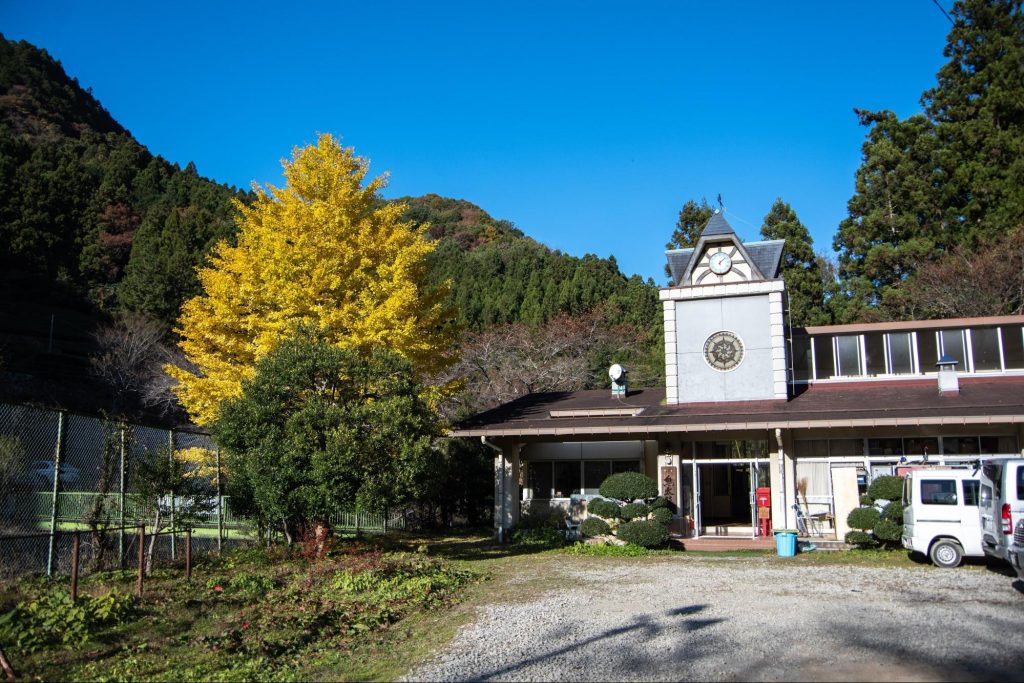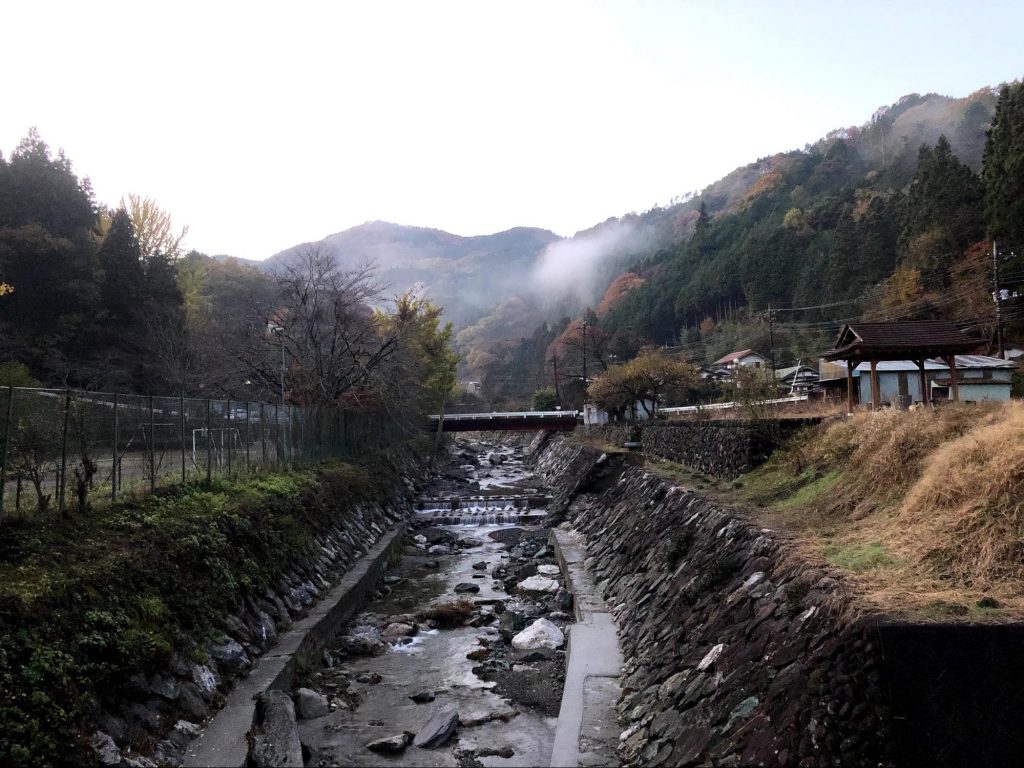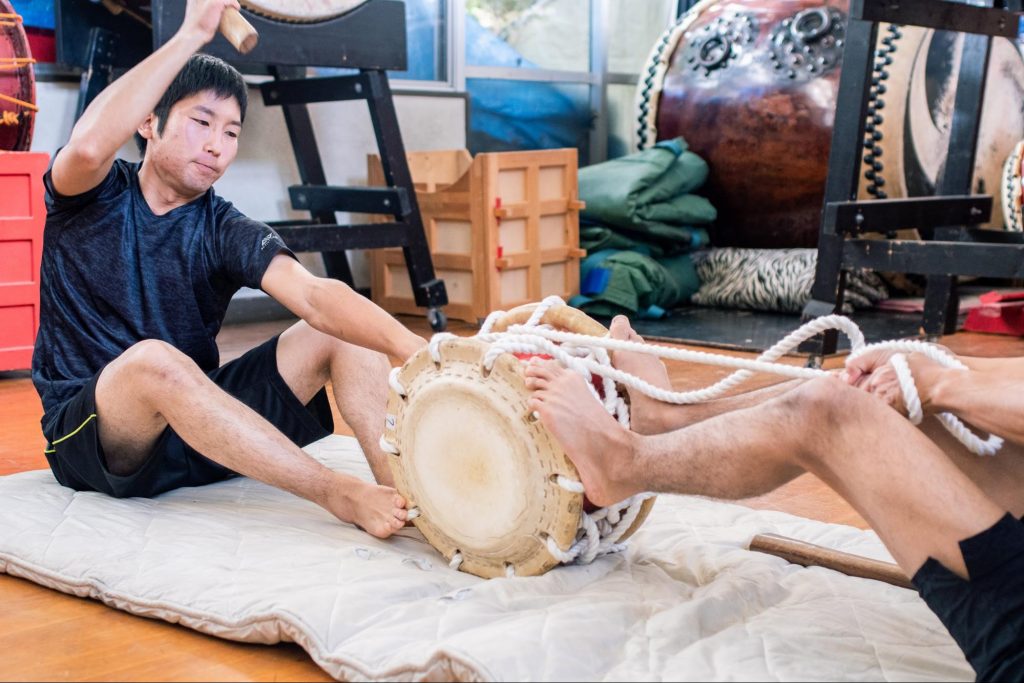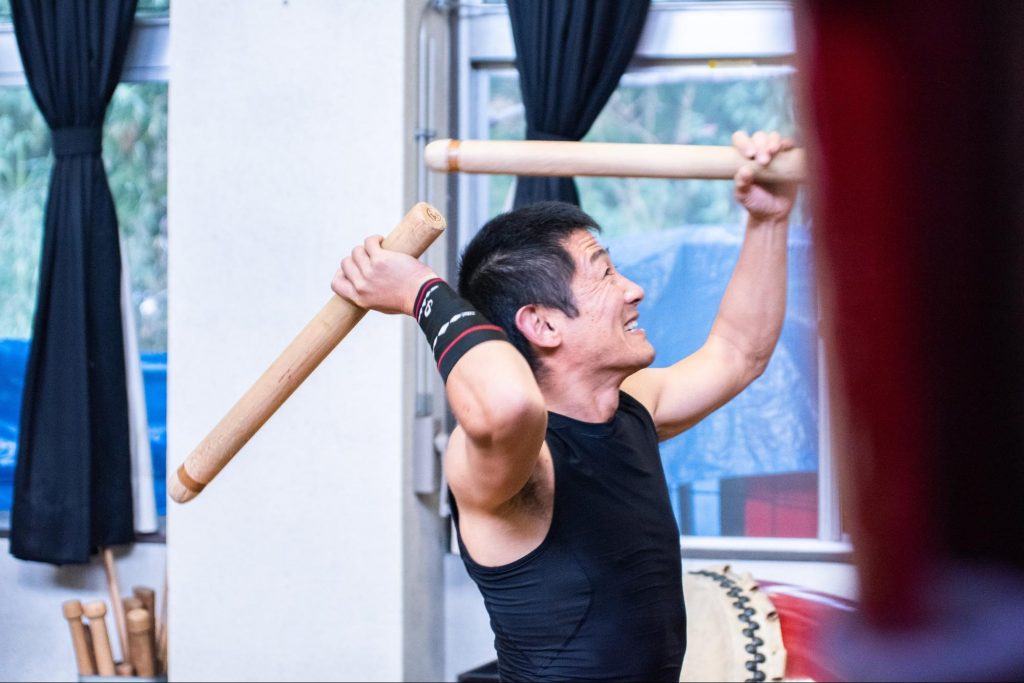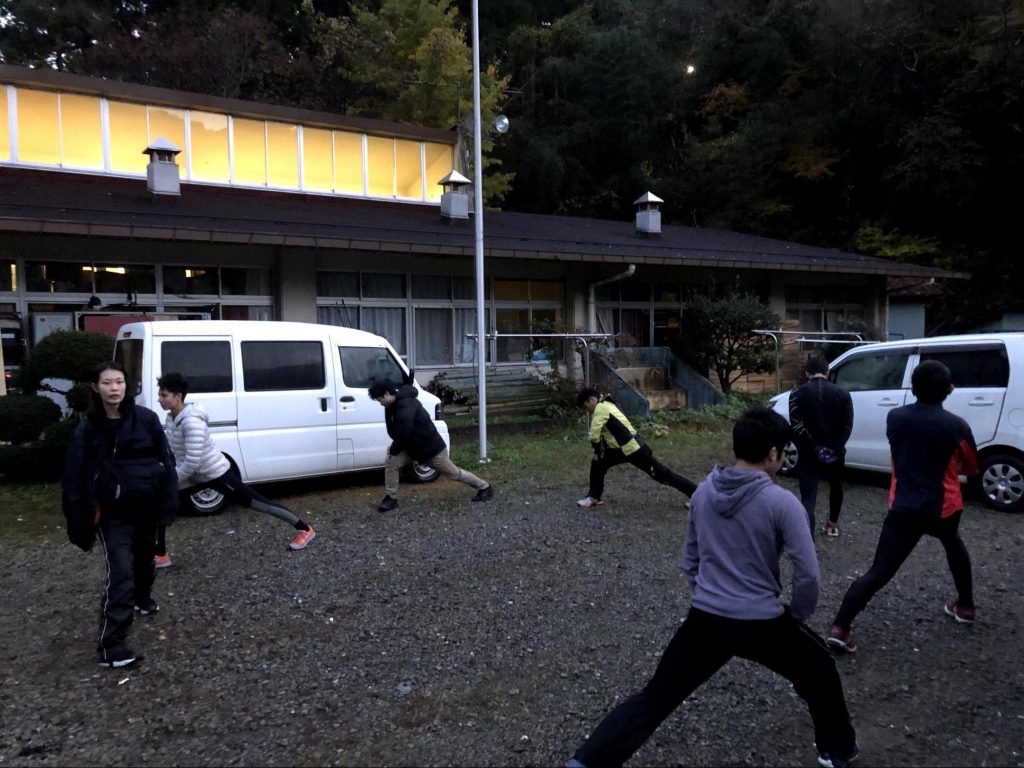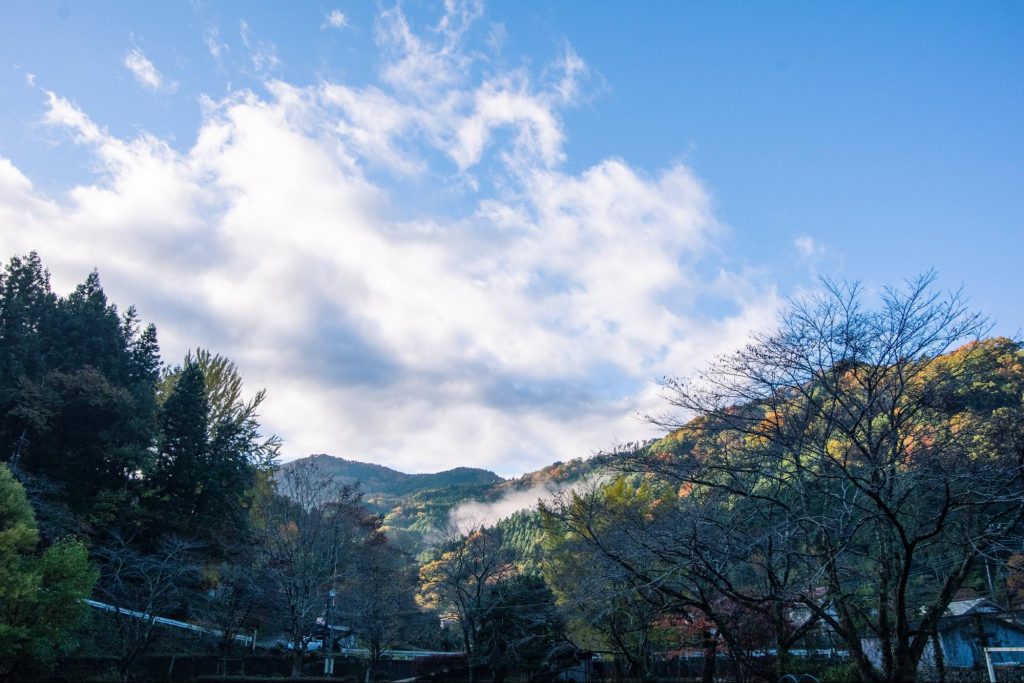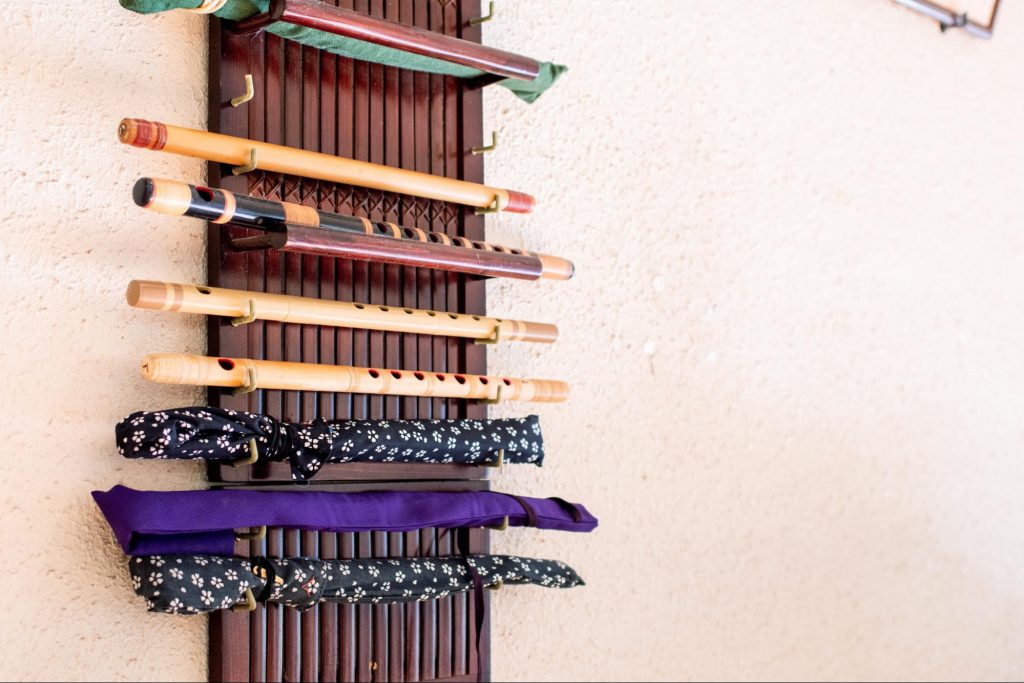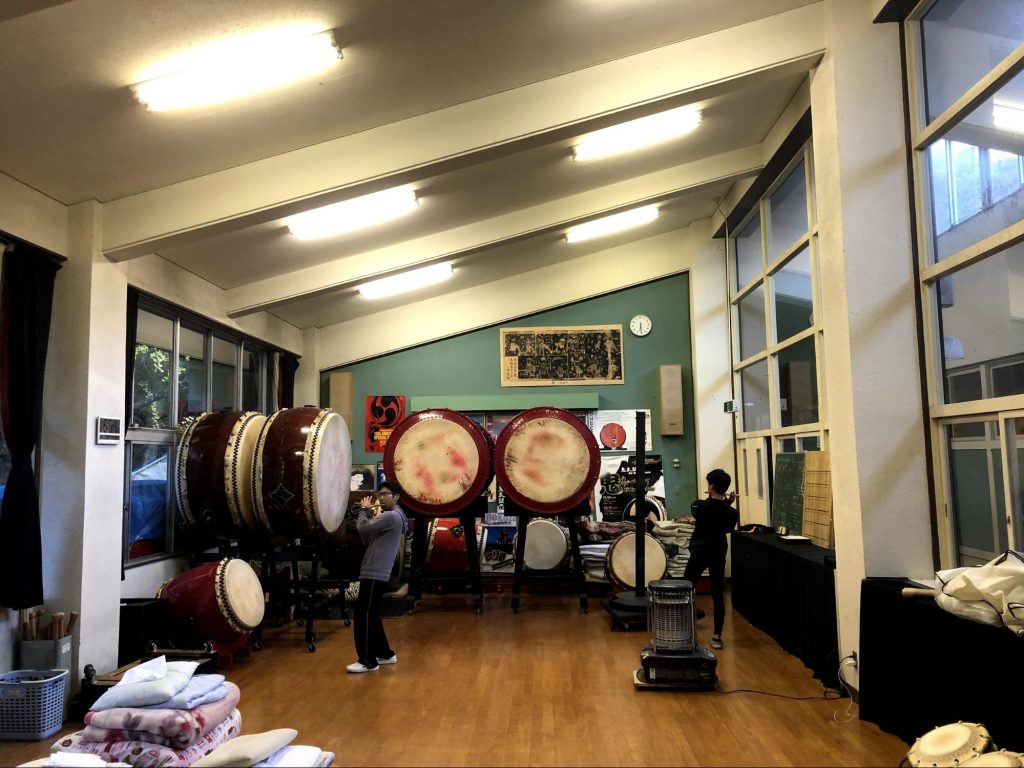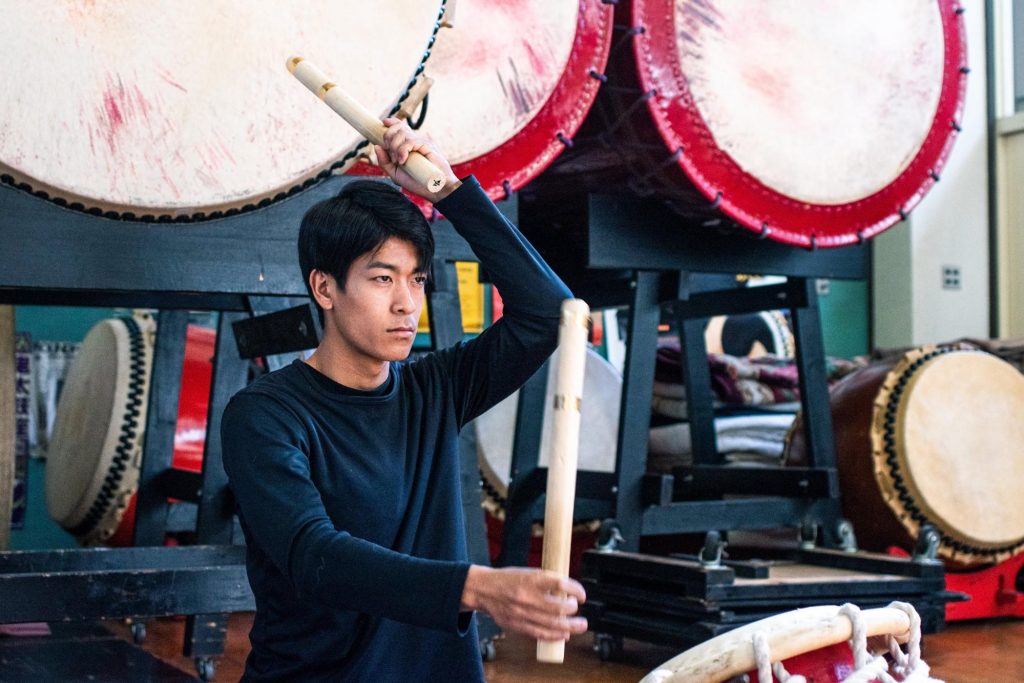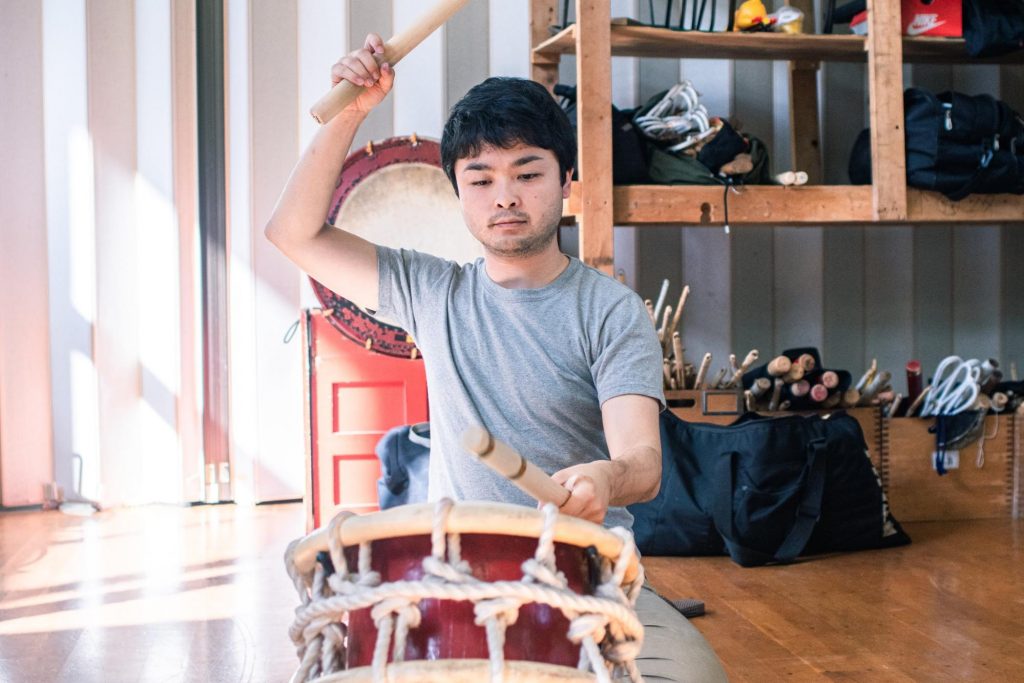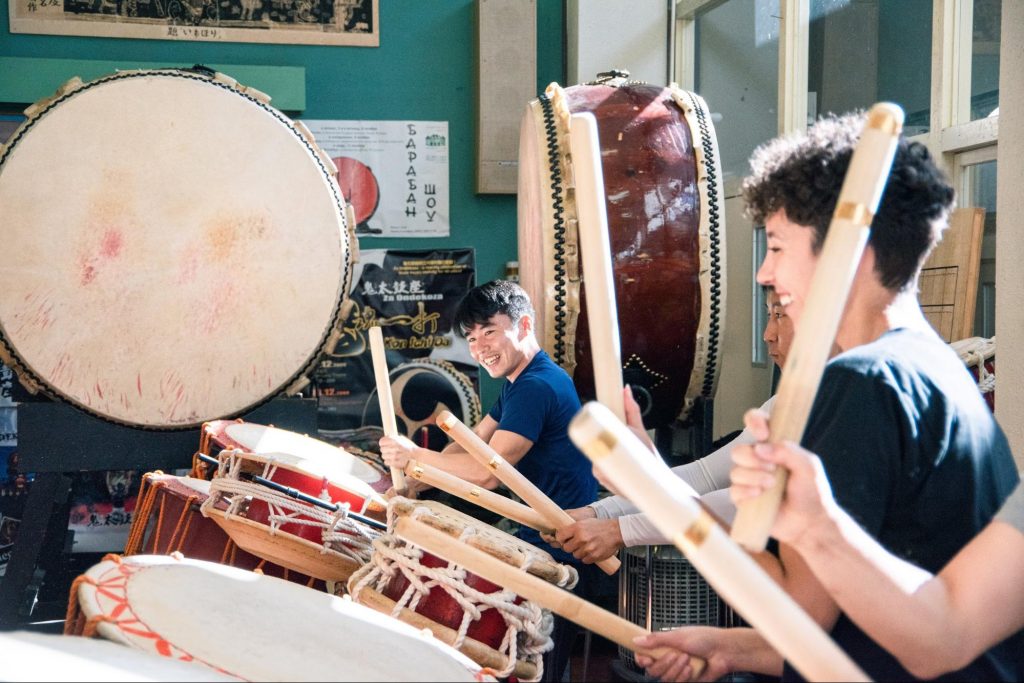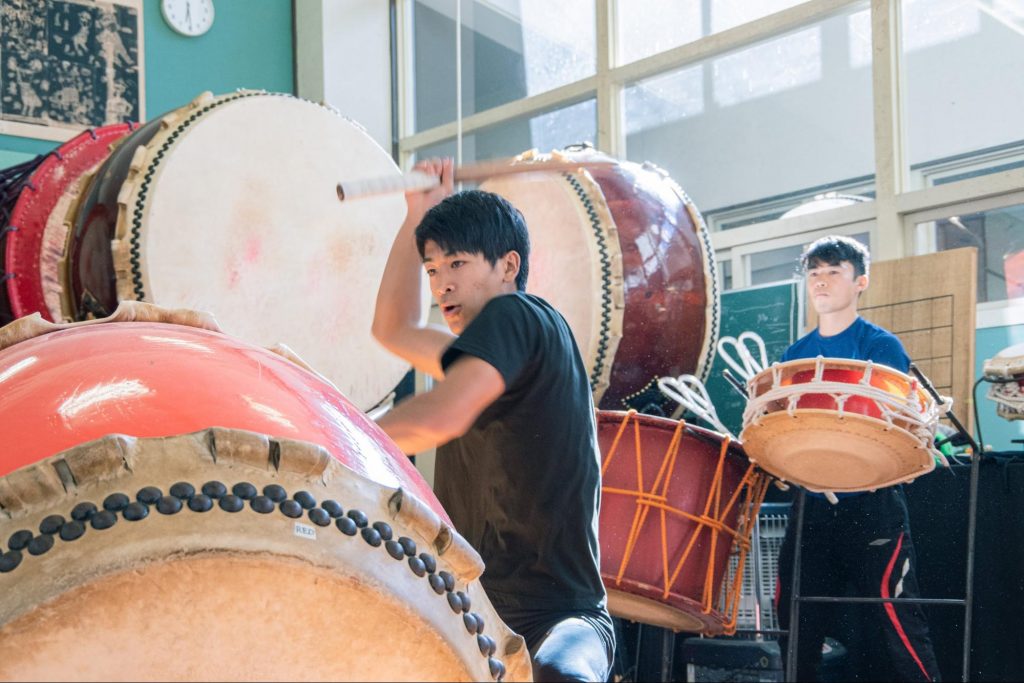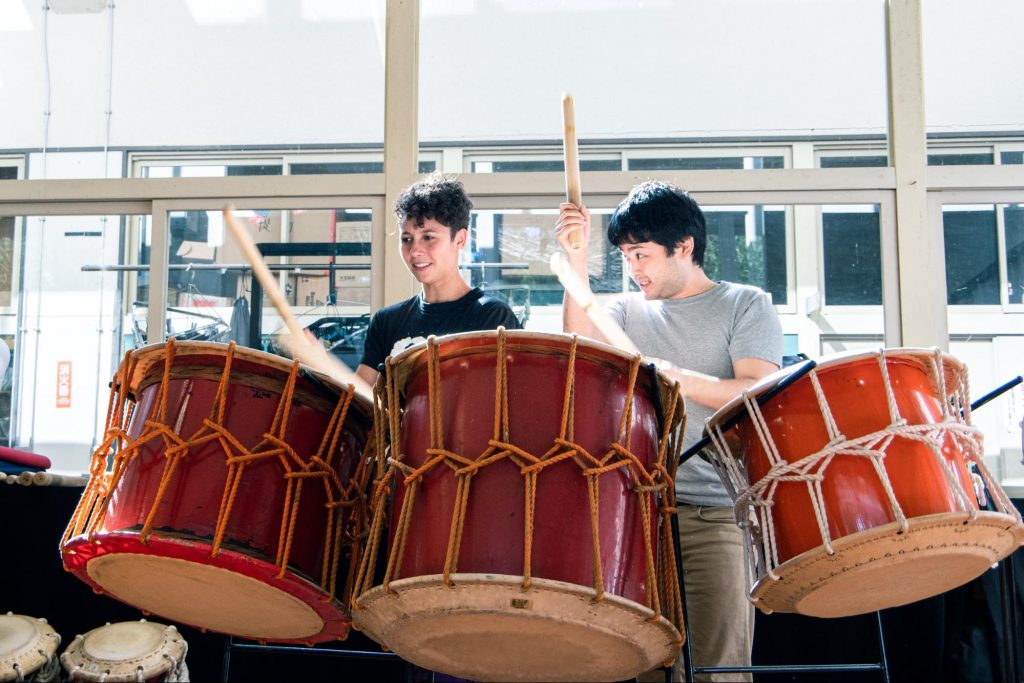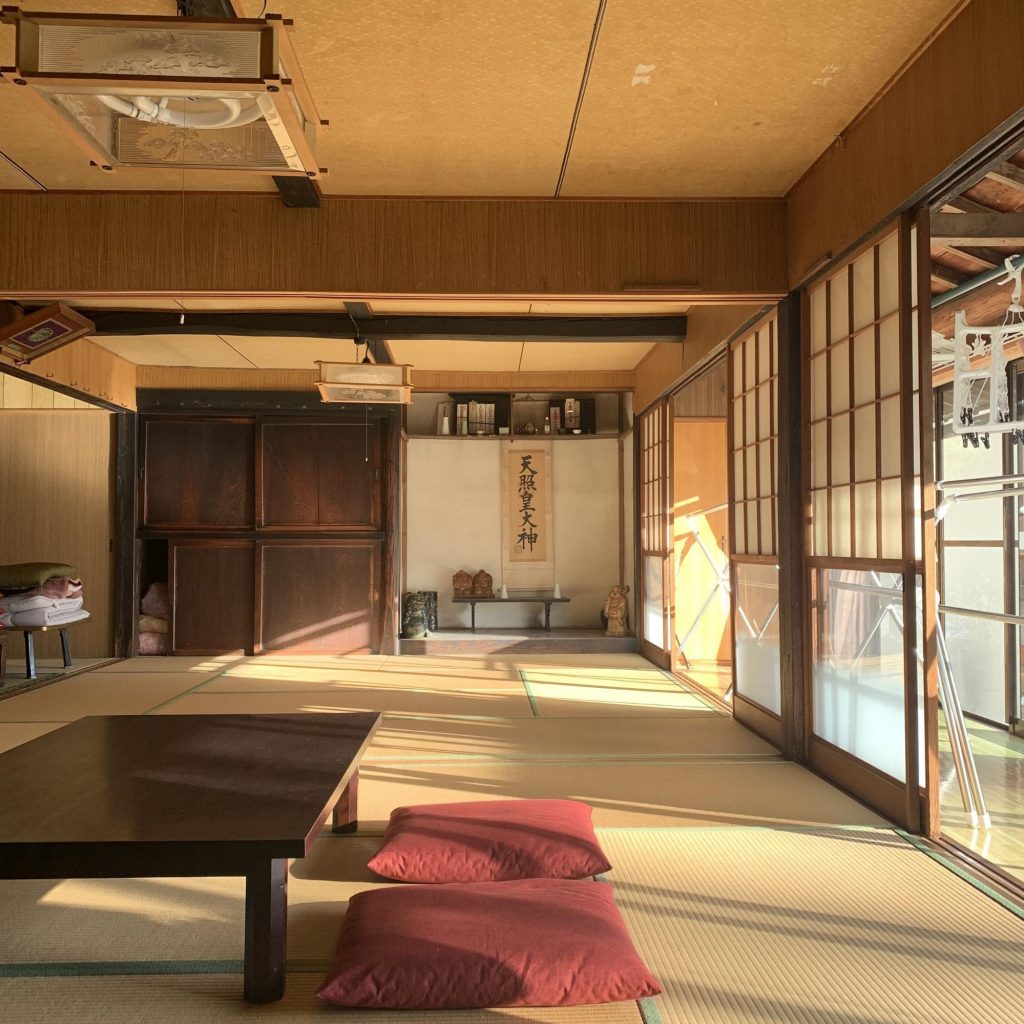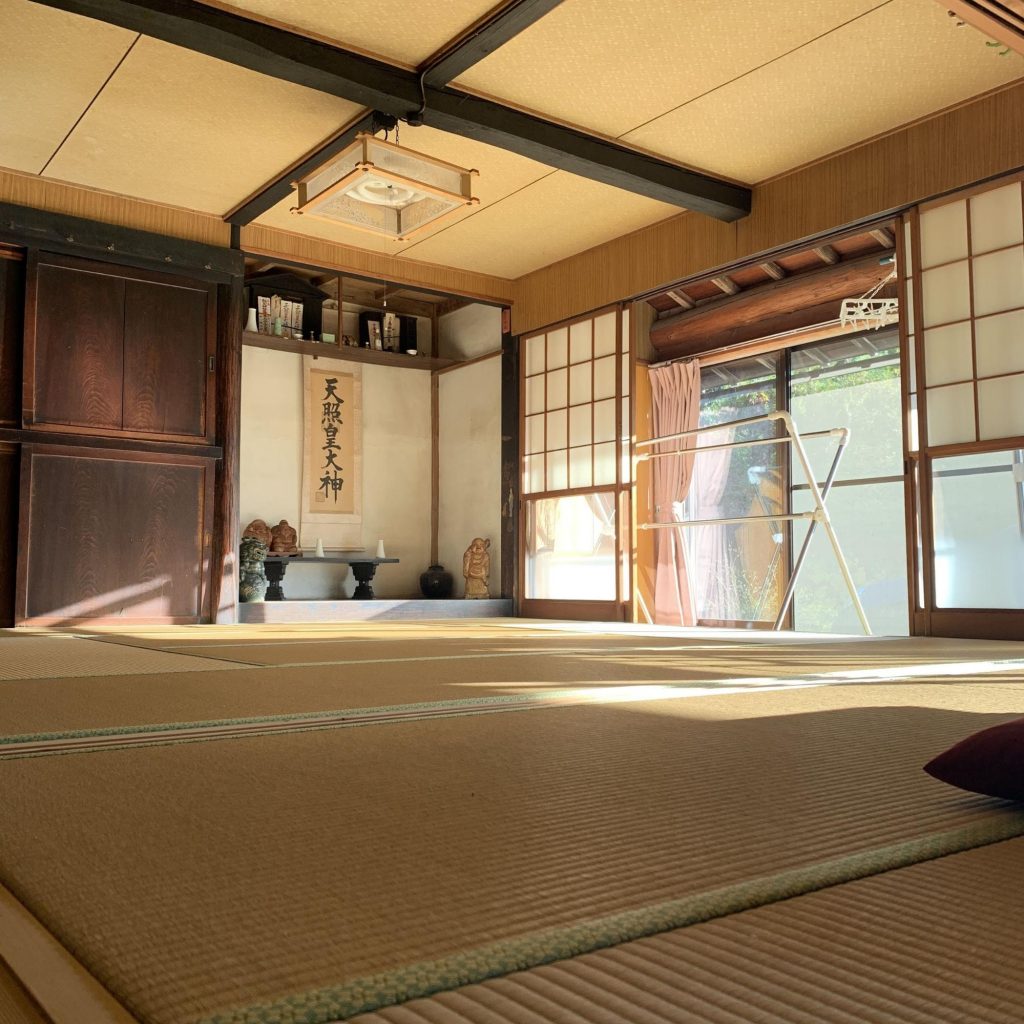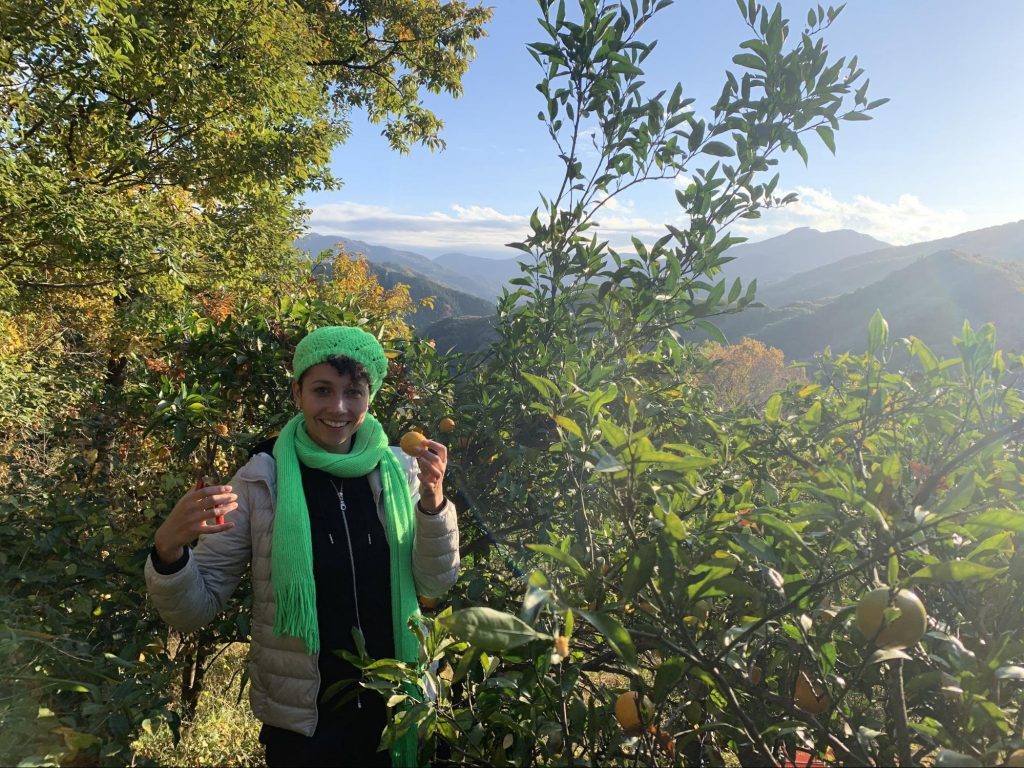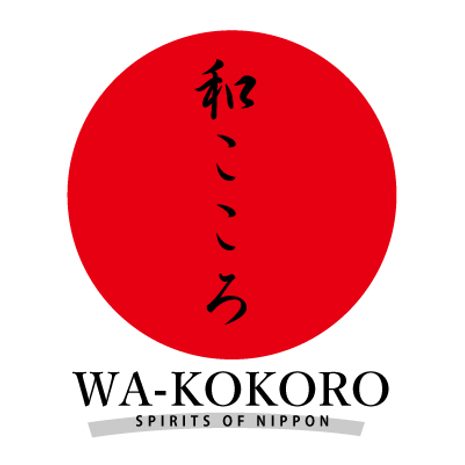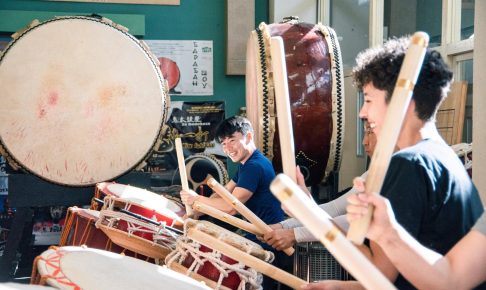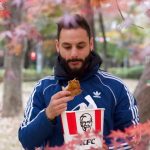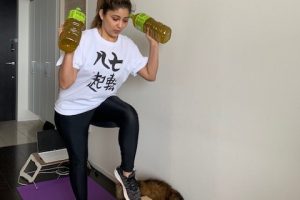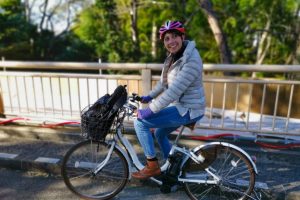
“Time to start! You will drum for 40 minutes non-stop.”
I was shivering in an abandoned elementary school that had been converted into the base for one of Japan’s most renowned taiko drumming group – Ondekoza, literally “Demon Drum Group”. On 4 hours of sleep and with a hacking cough, I wondered mildly if I were hallucinating the whole scenario.
But without any further time to prepare, I was drawn into a hypnotic rhythm only shattered by the growing pain in my arms… and my complete lack of rhythm.

This was no dream – or nightmare. This was a #TokyoChallenge from the Tokyo Survival Channel. I had agreed to spend two days training with the Ondekoza and drumming faster than my heartbeat. This was harder than any of my challenges so far. This time, it felt like it could actually be a matter of survival.
Who are Ondekoza?

“The amazing thing about Ondekoza is that they don’t care about how they are judged from outside. It just doesn’t matter. They decide their own value and that leads to their success,” says Masaya Hatta founder of Wakokoro, a project that aims to widen understanding of Japanese culture and the artisan mindset.
“In marketing, you design and work hard to define how you want to be viewed by others, so the market defines you. But Ondekoza does not work that way: they define themselves.”
This is probably just as well as their history and notoriously austere lifestyle would likely draw comparisons to a new age cult. Hailing from the island of Sado off the coast of Niigata Prefecture, Ondekoza were founded in 1969 by Den Tagayasu. Hailing from Asakusa in Eastern Tokyo, he was by all accounts a rebellious character, reportedly getting thrown out of Waseda University for taking part in protests.
“When Ondekoza was formed 50 years ago, the young people at the time felt there was no place for them in society. That is why we formed,” says Hiro Yoshi, Director of Ondekoza, who has been a member for over 20 years.
“So at our core, we have a rebellious spirit. It was a group of people wanting to voice something to society. Den san was very anti the US. The group started from there. It wasn’t born from an idea of ‘let’s do something fun on stage’.”
It is perhaps ironic, then, that the group gained widespread attention in the US early on in their history. Subscribing to the philosophy of “drumming and running as one” and as a reflection of the drama and energy of life, the group performed and received critical claim directly after running the Boston Marathon in 1975, and subsequently went on to tour the US, Europe and Japan.
Their style was revolutionary in many ways, transforming traditional festival music into a performance in its own right, and brought kumi-daiko (group drumming) as a genre into the global spotlight. They also popularised the performance style of wearing only a shimekomi (fundoshi loincloth), which sadly shatters the image of a tradition of semi-naked Japanese men beating drums in some ritual in ancient times.
Their lifestyle, however, is austere. Communal living centres around two practice sessions a day, with a 10km run at dawn. Free time is minimal, and as I was to find out, often involves periods of concentration of writing sutra (Buddhist scriptures).

Anyone of any gender and nationality can join the group, but numbers are sparse – currently, only 3 members live in their facilities and 5-6 members spread throughout (Japan), some only joining the others for performances.
To become a member, applicants must complete a trial year, paying a monthly stipulation of 60,000 yen per year to their cover board and living costs. If they successfully complete the year, they will be paid a salary in accordance with their ability with all funds coming from Ondekoza’s performances.
Despite minimal knowledge of the art to which they were dedicated, and definitely no experience, I was to be granted access beyond ordinary visitors: I was to train with them for 24 hours at their lodgings and facilities. I had never hit a drum before and I am certainly not used to running 10km. This was going to be a challenge.
Preparation
I had been tasked with going to a video game arcade to tackle the arcade game Taiko no Tatsujin—literally, “The Drum Player”—which is basically a rhythm game with various levels of increasingly insanely fast music. I thought it might also be an idea to… try running. By coincidence, the very same week, I heard that a legendary arcade was to close – the dystopian Anata no Warehouse that fuses cyberpunk aesthetics with a replica of the original Walled City of Kowloon.
A plan was born. I would run to the arcade, visiting it before it closed forever, and practise my drumming skills at the same time. Seemed like a win-win-win.
As it turns out, the arcade is 18km from my house. Fortunately, it also turns out that I love running when it is sunny and warm and I am on an adventure. I enjoyed my run so much that I detoured to make sure I hit 22km – a full half-marathon!
Mildly surprised at my random athletic feat, I arrived at the arcade ready to hit those drums, and fill the dystopian arcade with my own dystopian body odour.
Slotting my 100 yen in the machine, I attempted the “Simple” level and I rocked it, bobbing my body along and looking as cool as one can when holding plastic drum sticks.
So I set the difficulty level to “Normal” and instantly failed. You can watch the carnage here:
It was going to be a very long 48 hours.
*Drum roll* Let the challenge begin!

The team is assembled. Masa and Megu from Wakokoro, Hiro, project manager at Tokyo Challenge, and me, Freelance Writer in Purple Shiny Leggings. We’re driving towards the mountainous Chichibu region to the northwest of Tokyo. It’s a small rental car as the roads are still reportedly blocked from last week’s typhoon. The road begins to wind upwards and sure enough we meet a “road closed” sign. After some consultation on the phone, we’re told it’s perfectly fine to continue and, as casually as locals, we sail past and continue to climb.
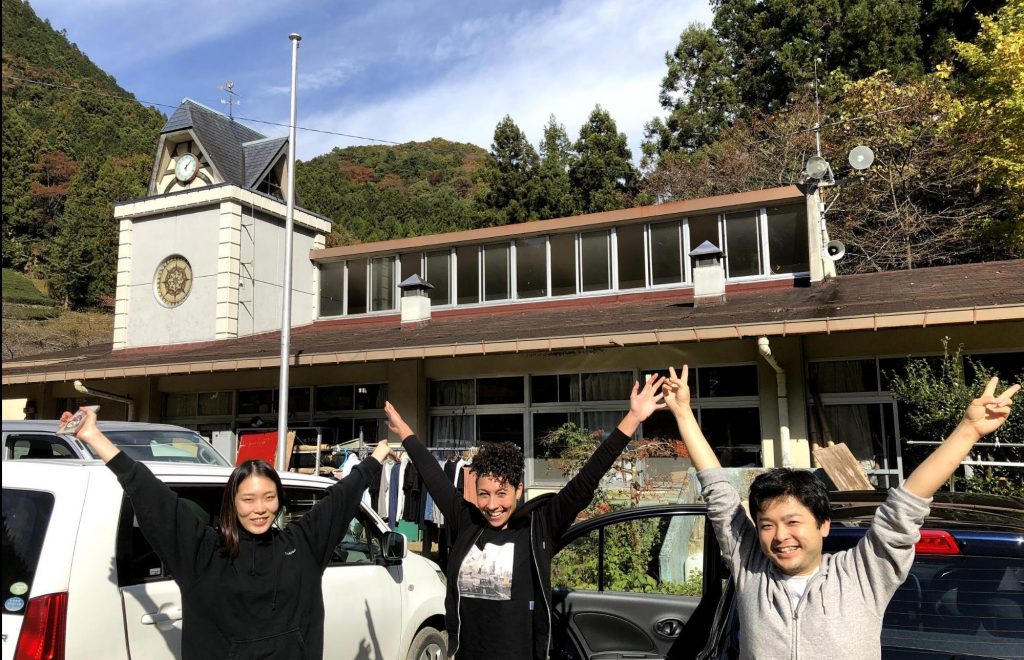
Next to a stream calving through the valley, we arrive at a disused elementary school that has become Ondekoza’s home. It’s smaller than I imagined. A simple clock tower above the entrance and what looks like about four classrooms along a corridor next to the hall. There’s a simple kitchen and a dining/living room space, which was probably once the teachers’ office or lounge. In its far corner is the only shower in the place, which was only installed last year.

The school was abandoned for about 16 years before Ondekoza renovated it and moved in. With only 5 houses in the vicinity, it’s the perfect base for very loud noises. They tell me taiko used to be used as a way of communicating the time over distance – the deep resonating sound of a larger drum can be heard up to 3km away.
Two of the members are clattering around in the kitchen, preparing lunch. It is a simple meal but I got my first taste of Ondekoza life: I am made to eat with my opposite hand. This is apparently an old army technique to make people eat more slowly during times of food shortage so as to feel more satisfied. As drummers, training both arms equally is also an advantage.
However, I am not a drummer and I am not naturally physically gifted. The unexpected prospect of eating an entire plate of noodles with chopsticks in my left hand presents quite a challenge. I am faced with an inner struggle between two of the worst aspects of my personality: pride versus greed. Pride wins out; I stab at the food on my plate and rejoice in picking up a tender chunk of local wild boar. The old man up the hill holds a hunting license, I hear, and he has had a particularly successful year, having shot a great number of deer too.

A drafty old school nestled in a forested valley seems an incongruous setting to be hearing tales of Ondekoza’s globetrotting. It’s hard to imagine the men assembled around the table travelling the world as international performers. I am sitting next to Seizan Matsuda, the leader of the group for 18 years... I am curious as to how a group structured around strict rules can avoid compromising when preparing performances for their audiences.
There is always some stress, he concedes, especially before a performance when the air is tense with expectation.
“At that moment, the audience and the performers are separated by an invisible wall. It is as if the hall is split into two worlds: the dream world presented by the performers and the world of reality with the audience,” Matsuda says.
“In a single beat of a taiko, the barrier between two worlds can be broken, and the two worlds melt into each other. This is the greatest charm, the power of taiko.”
There is no compromise because they believe in the power of their music. There is no conforming to expectations or markets.
“The taiko is beyond that. It’s an instrument that can break the tension in the air. One beat of drum that can change the atmosphere of the entire hall. I believe that is the true strength of taiko.”
The training begins

The hall has an array of drums of all shapes and sizes. The odaiko (large drums) tower over us whereas the shimedaiko are almost small enough to wrap your arms around. Ondekoza order them from a drum craftsman who specialises in attaching the leather skin to the body, usually wood from a Japanese zelkova tree. There are very few craftsmen who make all parts from scratch – perhaps less than 10, I’m told.
“The special thing about Japanese taiko is that you can hit both ends,” Yoshi explains. “The two leather skins vibrate and the noise resonates in the middle. It’s a very complicated sound. Depending on the wood, the shape, and the size of the body, the sound is different. And you can’t tune it.”
Apparently Japanese cows are too well fed; the fattiness has been causing the leather of the drum skin to become oily, reducing the quality.

I take some time testing the different drums. There are many different beaters from batons that look like baseball bats to bokuto, a kind of wooden sword. I am particularly taken with the futon spankers.

Yoshi gives us some basic pointers. Hit by moving your arm the shortest distance possible. Move straight, then flick the baton at the last minute. Imagine your body as an axis, a fixed point. Don’t move, except for your arms.
But I am hopelessly excited and keep wiggling around like an oversized toddler.

We begin by tightening (shimeru) the shimedaiko, which are small drums with both sides interlaced with ropes. This involves two people opposite each other, wedging the drum between their feet, while alternating between pulling the rope and precisely hitting the rope loops to tighten the binds. I watch the men work with swift synchronous movements, faces scrunched and veins pulsing as they strain through the task.
Then it is my turn. I try to wedge the drum between my feet but my legs are comically long compared to my body. The rope chafes against my skin as I tug, turning my palms deep pink. I raise the baton to strike the loop but I keep hitting the side of the drum.

My poor partner can barely hide his frustration as he tries to direct me. After several more attempts, I smash my left hand and end up cursing in the corner. The practice has not even begun yet. Sweat is already caressing our foreheads and our fingers are throbbing. It takes over 25 minutes for us amateurs to tighten the drums; Ondakoza normally finishes in under 10.

“You will drum for 40 minutes.”
It is not what I was expecting, although the name “Demon Drum Group” should have been a clue. I settle in front of a shimedaiko. The metronome is set and we begin, melding our movements to its relentless pace. I am not sure I have ever swung my arms continuously for 40 minutes. Somehow the rhythm, the noise, and the repetition draw me in. I don’t watch the clock. The pacesetter leads us through two waves, when we shrink our strikes at full force down to gentle taps before resuming the thunderous noise.
I can sort of see the appeal.

That thought comes a little too soon. 40 minutes are up. We have perhaps a minute to swap places. Now, I am in front of an odaiko, arms raised above my head weighed by heavy batons so thick that I can barely close my hands around them. I am standing among droplets of sweat from the previous drummer. I can almost smell the pain that is to come.
We begin and there is no meditative state, no therapeutic relief through repetition. I am perhaps only 20 minutes in when a feeling of nausea creeps up in my stomach and a tingly sensation creeps up my neck and encircles my head. I know the signs; I am about to faint. Sleep-deprived, and having caught an ill-timed cold, I swallow my pride and watch the rest of the proceedings from the side of the hall.
This is not supposed to be fun

At dinner, our weakened arms don’t take kindly to eating with our non-dominant hand. I fling cabbage onto my lap.
“There is nothing fun about what we do,” says Yoshi. “It is only painful.”
Then why do it, I ask.
“I am often asked that, but I can only answer like this. It is like digging a hole. Rather than trying hard to climb a mountain, it’s like digging down. There is no goal or moment when you’re like “Yes, I’ve finally struck oil!” We might practice as a group, but we all suffer individually.”
The last vestiges of my notions of a therapeutic and spiritual musical practice in the mountains dissipate.
“In our performance on stage, we are unleashing so much energy that comes from daily hard training and all the suffering. So I don’t want to see casual players on the stage, just enjoying being there and saying it’s fun. There is enough shallow entertainment already.”
So what do you want to see? I challenge him.
“I want to see a performance that comes from amazing effort, a performance so serious and real that the performer plays as if their life depends on it.”
Dawn
It’s just past 6 am and I am late. Ondekoza are already gathered outside, breath huffing in the cold morning air. We stretch in a circle and then suddenly they are flying down the hill, beginning their 10km run.
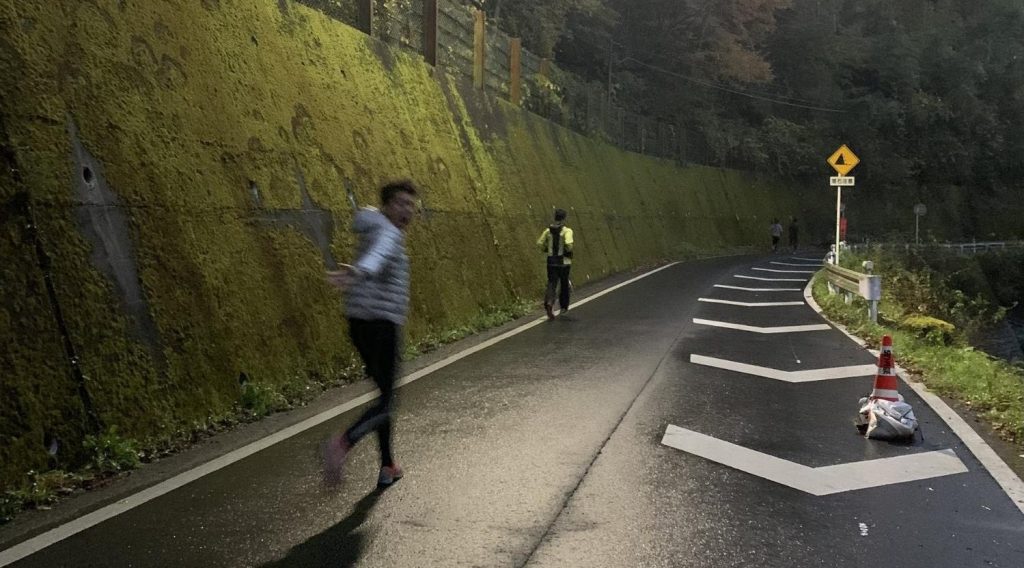
I chase after them for 1.5km before deciding that this steep downhill can only mean a steep uphill back and my cough has yet to abate. 22km practice run or no, I decide I’ve made enough of an effort.

The crew drive an embarrassingly short distance down the hill to collect me, despite my protests. I decide to pretend to be a casual hitchhiker to look cool for the camera.
Back outside the school, we soak up the morning light while waiting for them to return.

As suddenly as they departed, two members of Ondekoza fly back, swooping into the hall where, already breathless, they play the shinobue (Japanese bamboo piccolo) as hard as possible. Watching the swiftness of their movements and their spritely impossible energy, I am half-convinced this is Neverland and, like Peter Pan, they will soon start levitating, all the while still piccolo.
Whistle while you work

The morning gives us a taste of communal life. Preparing, serving, eating and clearing up breakfast together is followed by cleaning duties.
“We don’t have a particular list of what needs to be done in each room. There is the hall. Make it as clean as possible in 30 minutes.”
Brooms in hand, we set to work.
Next, the wall schedule says “Reading Book or Watching Video or Hand-copying of a Sutra.” I interpret this as “free time”, which turns out to be wishful thinking.
Naoto Kinoshita is leading us in sutra-writing. He’s 31 and joined Ondekoza 7 years ago, after studying agriculture in the US. He chants through the Buddhist scripture before giving us a thick, black calligraphy pen to trace the characters onto paper.

The goal is not to be fast, but to fully focus and write as beautifully as possible. He recommends we use our non-dominant hand, which I ignore. My right-hand handwriting in English looks like a 6-year-old’s, so there is no way I am attempting Chinese characters with my left. Sure enough, it is not long before my page is smudged with fingerprints and illegible squiggles. The silence feels like it is judging me.
I wish I could say I feel calm and focused, but I look at the paper and feel irrationally angry. A little voice in my head tells me to scribble all over it, which is definitely not very Buddhist.
Hit it as you like

Sensing our arm pain, the Ondekoza take pity on our pathetic bodies and only prescribe 30 minutes of shimedaiko drumming. The rhythm somehow still manages to be soothing, despite the relentless pace and wall of noise.

But then we do something special. To Ondekoza, it is something they do everyday. But to me, it changes how I feel about taiko entirely.
We are to do group improvisation. Hiro and I are directed to some medium-sized drums and begin to beat them, admittedly somewhat incoherently. Kinoshita is on another set, twirling futon spankers with style, next to another member. Finally one more joins in the fray, striking a large barrel drum on its side, in movements that seem part martial art, part dance. This might be a free for all, but we somehow fall in line with one another, Kinoshita signalling, directing, drawing us in and urging us on, building the momentum into a crescendo of thunderously deep taiko beats.
It is electrifying.
Unfortunately, I forget that my body is supposed to be an axis of stillness and I go full-on Tigger and bounce. I fear I am the opposite of the serious student they search for, but my unbridled enthusiasm elicits some grins.
Up to 50% of an Ondekoza performance is improvisation. I imagine what it must be like to see them live, to be them performing live, feeding off the energy, communicating through the music with each other and the audience. Ondekoza life might be about individual suffering, but there is a sheer raw unifying energy through the power of the taiko.
Ondekoza experience
We take lunch and I feel energised.

Ondekoza are planning with Wakokoro to offer a 3-day, 2-night taiko experience for those who truly want to understand their way of life and the power of the taiko. We go to visit the lodgings for future guests—a beautifully renovated kominka (old Japanese house) that sleeps up to ten.
Then, just up the hill, we head up to some mikan (mandarin orange) trees and pick as many as we can. Casually dressed, with warm autumn sun on our faces and mikan juice sticky on our fingers, we eat as freely as we load our baskets. Ondekoza life doesn’t seem so far away after all.
Drumming skill test
A few days later, I am staring up at a giant space invader plastered on a red sign. I’m outside a Taito Game Station and it is time for my final drumming challenge.
Video below (the machine had very low sound sadly…):
Shockingly… my skill level hasn’t improved. Even more shockingly, I’m just not impressed. Having experienced Ondekoza taiko, I can’t quite bring myself to fully enjoy this pale imitation—light-hearted game though it is. Somehow, my mind keeps drifting back to a school in the mountains. Maybe I’ll challenge myself again.
Photos by Megumi Yoshida
